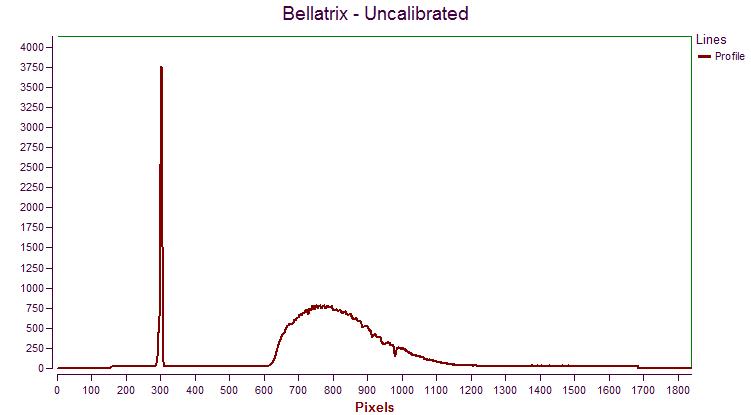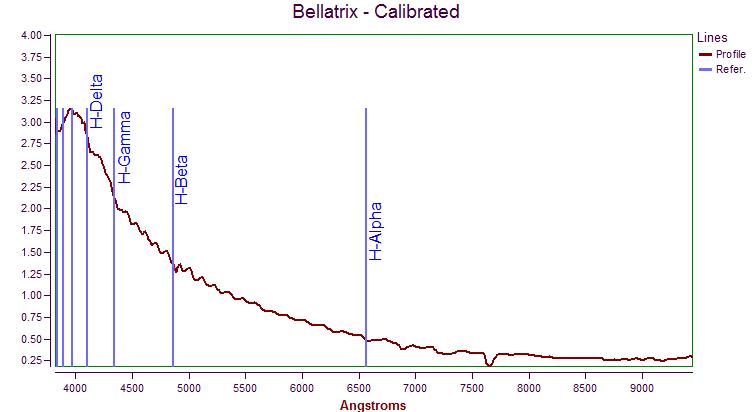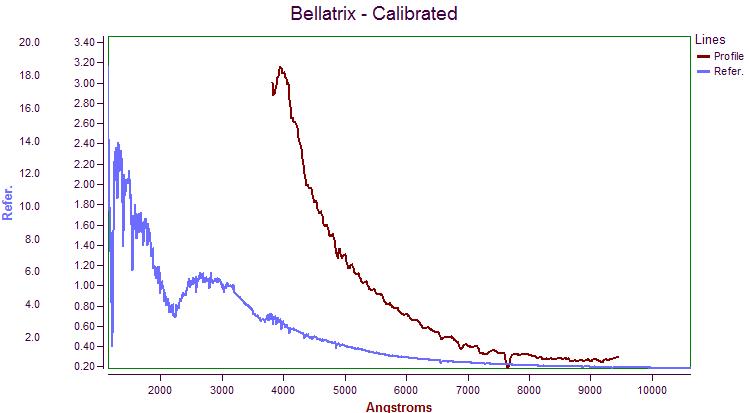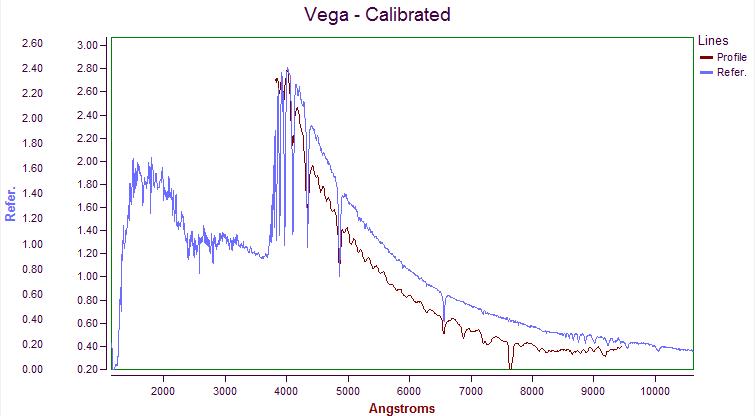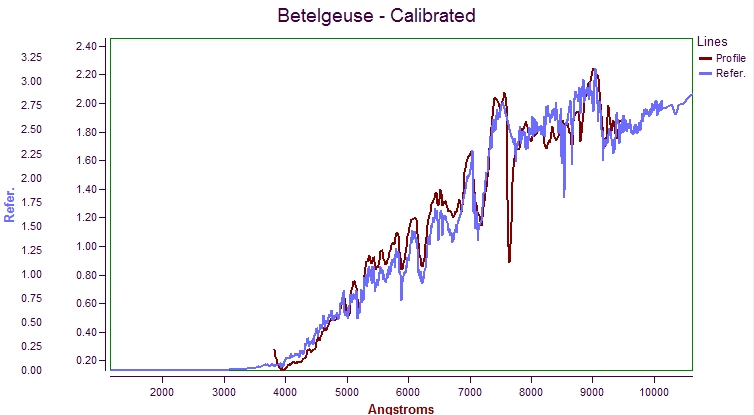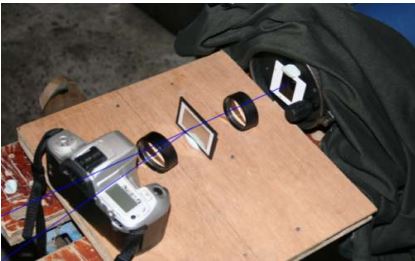- Posts: 6335
- Thank you received: 315
Using a Star Analyser - Blog
- michaeloconnell
- Topic Author
- Offline
- Administrator
-

Less
More
11 years 1 month ago #99650
by michaeloconnell
Replied by michaeloconnell on topic Re: Using a Star Analyser - Blog
You're welcome Mike.
The purpose of this blog is to share what I am learning and hopefully encourage others to join in.
If anyone has any questions, of course, please ask.
Michael.
The purpose of this blog is to share what I am learning and hopefully encourage others to join in.
If anyone has any questions, of course, please ask.
Michael.
Please Log in or Create an account to join the conversation.
- michaeloconnell
- Topic Author
- Offline
- Administrator
-

Less
More
- Posts: 6335
- Thank you received: 315
11 years 1 month ago - 11 years 1 month ago #99651
by michaeloconnell
Replied by michaeloconnell on topic Re: Using a Star Analyser - Blog
I mentioned earlier about the use of a Type A star to begin with.
Vega and Sirius are examples of Type A stars.
You may ask what are Type A stars?
Type A is their spectral classification.
Basically, when you look are a large number of stars with a spectroscope, patterns will develop and stars can be classified into different types.
The main types are:
O, B, A, F, G, K and M
O are the coolest and M are the hottest.
This can be easily remembered with the mnemonic "Oh, Be A Fine Guy/Girl, Kiss Me"
For more, read:
en.wikipedia.org/wiki/Stellar_classification
Going back to the beginning, instead of using Vega, let's say I try and use Bellatrix - a nice bright star in Orion.
If you compare this chart to the first one for Vega, you will see that the graph is much smoother - not as many spectral lines to calibrate our system.
Because Bellatrix is a Type B star, many of it's spectral lines are beyond the range of the camera to detect.
Therefore, it's not the best star to calibrate with on day one.
If we use the calibration data we used for Vega and get the spectrum for Bellatrix taking into account of the camera, the spectrum for Bellatrix will look like this:
I have inserted the Hydrogen Balmer lines for comparison.
If we overlay the standard spectrum for a Type B star, we get this:
Note how many of the spectral lines are located to the left of our red curve.
i.e. we can't detect them.
Compare that to the one for Vega we had earlier
Hopefully this demonstrates the difference between different star types and why we need to use Type A stars initially to calibrate our system.
Vega and Sirius are examples of Type A stars.
You may ask what are Type A stars?
Type A is their spectral classification.
Basically, when you look are a large number of stars with a spectroscope, patterns will develop and stars can be classified into different types.
The main types are:
O, B, A, F, G, K and M
O are the coolest and M are the hottest.
This can be easily remembered with the mnemonic "Oh, Be A Fine Guy/Girl, Kiss Me"
For more, read:
en.wikipedia.org/wiki/Stellar_classification
Going back to the beginning, instead of using Vega, let's say I try and use Bellatrix - a nice bright star in Orion.
If you compare this chart to the first one for Vega, you will see that the graph is much smoother - not as many spectral lines to calibrate our system.
Because Bellatrix is a Type B star, many of it's spectral lines are beyond the range of the camera to detect.
Therefore, it's not the best star to calibrate with on day one.
If we use the calibration data we used for Vega and get the spectrum for Bellatrix taking into account of the camera, the spectrum for Bellatrix will look like this:
I have inserted the Hydrogen Balmer lines for comparison.
If we overlay the standard spectrum for a Type B star, we get this:
Note how many of the spectral lines are located to the left of our red curve.
i.e. we can't detect them.
Compare that to the one for Vega we had earlier
Hopefully this demonstrates the difference between different star types and why we need to use Type A stars initially to calibrate our system.
Last edit: 11 years 1 month ago by michaeloconnell.
The following user(s) said Thank You: Fermidox, manic_dave
Please Log in or Create an account to join the conversation.
- manic_dave
- Offline
- Main Sequence
-

Less
More
- Posts: 333
- Thank you received: 149
11 years 1 month ago #99653
by manic_dave
www.skelligstarparty.com
Europe's Darkest Skies
Top 4 Locations in the world to Stargaze by Paste Magazine.
Replied by manic_dave on topic Re: Using a Star Analyser - Blog
Michael, would that work on a comet ?
Would it give you an idea about what its made of?
Would it give you an idea about what its made of?
www.skelligstarparty.com
Europe's Darkest Skies
Top 4 Locations in the world to Stargaze by Paste Magazine.
Please Log in or Create an account to join the conversation.
- michaeloconnell
- Topic Author
- Offline
- Administrator
-

Less
More
- Posts: 6335
- Thank you received: 315
11 years 1 month ago - 11 years 1 month ago #99654
by michaeloconnell
Replied by michaeloconnell on topic Re: Using a Star Analyser - Blog
It sure would.
www.astrosurf.com/~buil/comet/lovejoy/obs.htm
This link is also worth looking at:
www.rspec-astro.com/sample-projects/#comet
and for some light-hearted test results:
www.astrosurf.com/~buil/liquid_spectro/result.htm
www.astrosurf.com/~buil/comet/lovejoy/obs.htm
This link is also worth looking at:
www.rspec-astro.com/sample-projects/#comet
and for some light-hearted test results:
www.astrosurf.com/~buil/liquid_spectro/result.htm
Last edit: 11 years 1 month ago by michaeloconnell.
The following user(s) said Thank You: manic_dave
Please Log in or Create an account to join the conversation.
- michaeloconnell
- Topic Author
- Offline
- Administrator
-

Less
More
- Posts: 6335
- Thank you received: 315
11 years 1 month ago #99666
by michaeloconnell
Replied by michaeloconnell on topic Re: Using a Star Analyser - Blog
Please Log in or Create an account to join the conversation.
- albertw
- Offline
- IFAS Secretary
-

Less
More
- Posts: 4173
- Thank you received: 181
11 years 1 month ago #99691
by albertw
Albert White MSc FRAS
Chairperson, International Dark Sky Association - Irish Section
www.darksky.ie/
Replied by albertw on topic Re: Using a Star Analyser - Blog
Impressive Michael!
I did a spectroscopy project a few years back (2005) getting spectra of various star types. My setup was a lot less elegant though
I did a spectroscopy project a few years back (2005) getting spectra of various star types. My setup was a lot less elegant though
Albert White MSc FRAS
Chairperson, International Dark Sky Association - Irish Section
www.darksky.ie/
Please Log in or Create an account to join the conversation.
Time to create page: 0.134 seconds


